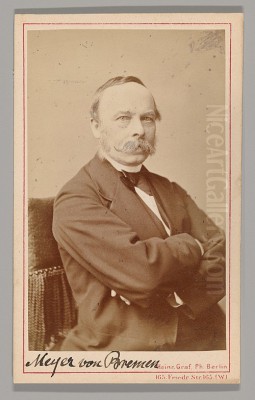
Johann Georg Meyer (1813-1886), who later adopted the suffix "von Bremen" after his birthplace, was a significant German painter of the 19th century. He carved a distinct niche for himself within the vibrant German art scene, becoming particularly celebrated for his charming and sentimental genre paintings. His works often focused on the intimate moments of family life, the innocence of childhood, and the daily realities of peasant communities, resonating deeply with the sensibilities of his time. Associated primarily with the influential Düsseldorf School of painting, Meyer von Bremen's art offers a valuable window into the social and cultural milieu of mid-19th century Germany.
Early Life and Artistic Formation in Düsseldorf
Born in the Free Hanseatic City of Bremen in 1813, Meyer's artistic inclinations led him, at the age of 21, to the prestigious Düsseldorf Academy of Fine Arts (Kunstakademie Düsseldorf). This institution was a powerhouse of artistic training in Germany, particularly during the first half of the 19th century. It became the cradle of the renowned Düsseldorf School of painting, a movement characterized by its detailed realism, narrative clarity, and often, a touch of Romantic sentiment.
At the Academy, Meyer studied under the guidance of Friedrich Wilhelm Schadow (1788-1862), a prominent painter and the Academy's director. Schadow, himself the son of the notable neoclassical sculptor Johann Gottfried Schadow (1764-1850), was instrumental in shaping the Academy's curriculum and reputation. He fostered an environment that emphasized meticulous draftsmanship, careful composition, and often, subjects drawn from history, religion, or literature, executed with a high degree of finish.
The Düsseldorf School attracted artists from across Germany, Scandinavia, and even America. Meyer trained alongside figures who would become leading names in German art, such as the landscape painters Andreas Achenbach (1815-1910) and Oswald Achenbach (1827-1905), the historical painter Karl Friedrich Lessing (1808-1880), and the portraitist Carl Sohn (1805-1867). This environment undoubtedly influenced Meyer's technical proficiency and his approach to narrative painting.
Shift Towards Genre Painting
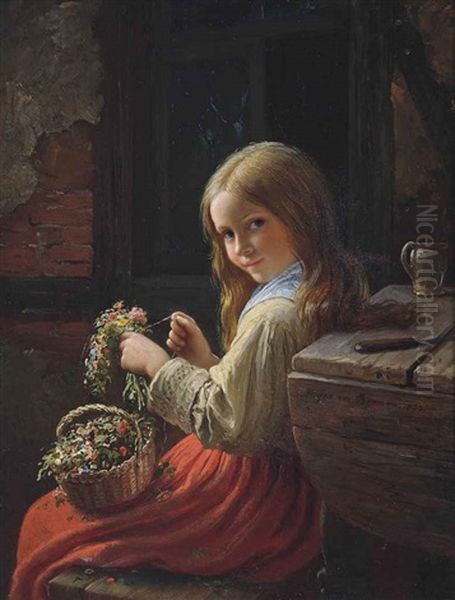
Initially, Meyer von Bremen explored biblical themes, a common starting point for artists trained in the academic tradition fostered by Schadow and the Nazarene movement's influence. However, he soon found his true calling in the depiction of everyday life. A significant shift occurred in his subject matter as he turned his attention towards genre scenes, particularly focusing on the lives of peasants.
He developed a special interest in portraying the rural communities of the Hessian region. Works from this period aimed to capture the character and customs of these communities, often imbued with what contemporary accounts described as a "deep sympathy for the simple life of the poor." This move aligned with a broader European trend in the 19th century where artists began to find value and pathos in the lives of ordinary people, moving away from purely historical or mythological subjects.
His approach was distinct. While grounded in the detailed observation promoted by the Düsseldorf School, Meyer's paintings often carried a strong sentimental or anecdotal quality. He excelled at capturing tender moments, familial bonds, and the unaffected charm of children. This focus on sentiment and domesticity also connects his work to the Biedermeier period's cultural ethos, which emphasized home, family, and a certain inward-looking comfort in the German-speaking lands between roughly 1815 and 1848.
Establishing a Career: Düsseldorf and Berlin
After completing his studies, Meyer von Bremen remained in Düsseldorf, a thriving artistic center. In 1841, he opened his own studio, signaling his establishment as an independent professional artist. During this period, he began producing works that cemented his reputation as a master of genre painting. An early example mentioned in historical records is The Celebrations of the Parson of Haldenfels (1843), indicative of his focus on rural life and narrative scenes.
His paintings gained popularity, appealing to a growing middle-class audience that appreciated relatable subjects rendered with skill and emotional warmth. His success and rising fame eventually prompted a move. In 1853, Meyer relocated to Berlin, which was rapidly becoming the political and cultural capital of Prussia and, later, the unified German Empire.
In Berlin, Meyer von Bremen continued his prolific output. His studio became a recognized name, and his works were frequently exhibited. His popularity extended beyond Germany; his paintings found eager collectors in the United States as well, where his sentimental depictions of childhood and family life struck a chord. The accessibility and emotional appeal of his subjects, combined with his polished technique, ensured a wide and appreciative audience throughout his career.
Artistic Style and Signature Themes
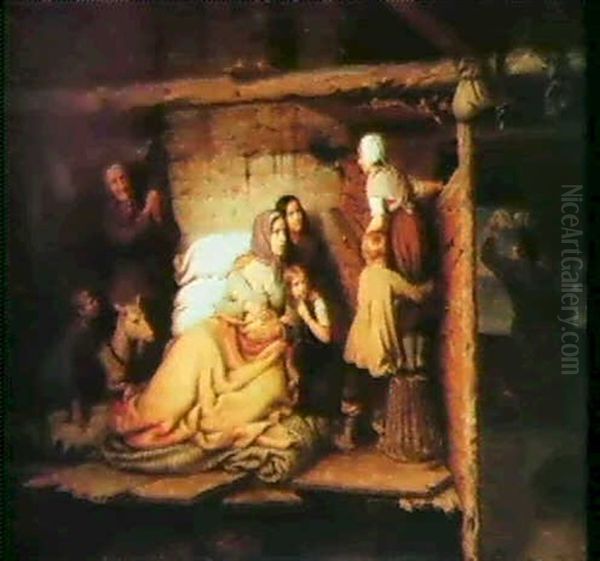
Meyer von Bremen's style is characterized by its meticulous attention to detail, smooth finish, and clear, narrative compositions. He employed delicate brushwork to render textures, fabrics, and facial expressions with remarkable precision. His paintings often feature carefully arranged interiors or contained outdoor settings that frame the human interactions at their core. The lighting is typically clear and even, illuminating the scene and highlighting the emotional focus.
His most enduring theme is arguably childhood. He possessed a remarkable ability to capture the innocence, playfulness, and sometimes the quiet contemplation of children. Works like The Little Flower Girl (1853) and The Fairy Tale (1853) exemplify this focus. He often depicted children interacting with each other, with pets, or with loving grandparents, emphasizing themes of family harmony and generational connection, as seen in works like Grandchildren and Grandparents.
While often sentimental, his work was not always saccharine. He also tackled more poignant aspects of life, depicting moments of hardship, sorrow, or moral reflection. His interest in the "pathos of family life" suggests an awareness of the complexities beneath the surface of domestic tranquility. This blend of charm and underlying emotional depth contributed to the broad appeal of his art. His style represents a specific vein within 19th-century German art, less monumental than the history painting favored by some Düsseldorf colleagues, and distinct from the atmospheric landscapes of Romantics like Caspar David Friedrich (1774-1840) or the burgeoning, grittier Realism of Adolph Menzel (1815-1905) in Berlin.
Representative Works and Their Subjects
Several paintings stand out as representative of Meyer von Bremen's oeuvre:
The Repentant Daughter (1852): This work, now housed in the Kunsthalle Bremen, tackles a more dramatic and emotional theme. It likely depicts a moment of familial reconciliation or moral reckoning, showcasing Meyer's ability to convey narrative and emotion within a domestic setting. Its presence in a major German museum underscores its significance.
Blind Man's Buff (often dated 1852, sometimes titled Children Playing Blind Man's Buff): This subject, which he seems to have painted more than once, perfectly encapsulates his skill in depicting the lively energy and innocent joy of children at play. The meticulous rendering of the figures and their environment would be typical of his style. (Note: Some sources confusingly translate the title related to "massage," but "Blind Man's Buff," the game, is the standard interpretation).
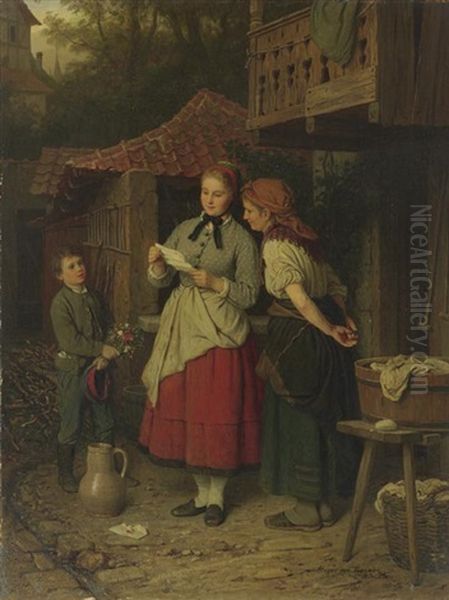
The Flood (often dated 1864, though earlier dates sometimes appear): This title suggests a departure towards a more dramatic, perhaps even catastrophic, event. It indicates his willingness to engage with themes beyond simple domestic bliss, touching upon hardship and resilience, possibly reflecting contemporary events or historical accounts.
Christmas Eve (often dated 1850): While the exact painting and its current location are difficult to pinpoint definitively from available records, the title suggests a theme perfectly suited to Meyer's focus on family, tradition, and heartwarming moments, especially popular during the Biedermeier and later 19th century.
The Letter (1873): Housed in the Metropolitan Museum of Art in New York City, this later work exemplifies his continued interest in intimate, narrative moments, often focusing on young women. Such paintings might depict anticipation, quiet reflection, or communication, rendered with his characteristic detail and smooth finish. Other similar titles from this period include The Love Letter (1873) and The Encounter (1873).
The known locations of The Repentant Daughter and The Letter confirm his presence in significant public collections. The current whereabouts of many other works, including The Celebrations of the Parson of Haldenfels, Blind Man's Buff, The Flood, and Christmas Eve, are less clearly documented in readily accessible sources, likely residing in private collections or regional museums.
Context within 19th Century German Art
Johann Georg Meyer von Bremen worked during a dynamic period in German art history. He began his career when Romanticism still held sway, particularly in centers like Düsseldorf under Schadow's early influence. His shift towards genre painting mirrored a broader European movement towards Realism and the depiction of contemporary life. However, his style retained a degree of sentimentality and idealization that distinguishes it from the more objective or critical Realism of artists like Wilhelm Leibl (1844-1900) in Germany or Gustave Courbet (1819-1877) in France.
He was a key figure within the Düsseldorf School, which itself evolved over the century. While he shared the school's emphasis on technical skill and narrative, his focus on intimate, often Biedermeier-inflected themes set him apart from those specializing in grand historical canvases or dramatic landscapes. His contemporaries included not only the Achenbach brothers and Lessing from his Düsseldorf days but also Berlin-based artists like Menzel, whose work explored urban life and historical moments with a different kind of energy and psychological depth.
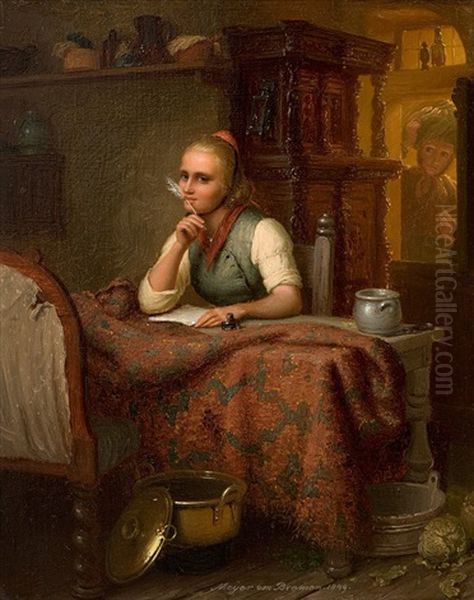
Interestingly, despite being active in the same artistic centers (Düsseldorf and later Berlin), there is no documented evidence of direct personal interaction or collaboration between Meyer von Bremen and major figures like Caspar David Friedrich (though Friedrich's main activity predated Meyer's peak) or Adolph Menzel. Their artistic paths and perhaps social circles seem to have diverged. Meyer's world appears more closely aligned with other successful genre painters like Ludwig Knaus (1829-1910) and Benjamin Vautier (1829-1898), both also associated with the Düsseldorf School and known for their popular depictions of peasant life and everyday scenes. His work can also be seen in relation to the charming, anecdotal paintings of Carl Spitzweg (1808-1885), another chronicler of German Biedermeier life, though Spitzweg worked primarily in Munich. Meyer's focus remained distinct from the more classical or allegorical tendencies of artists like Anselm Feuerbach (1829-1880) or the emerging Symbolism of Arnold Böcklin (1827-1901).
Reception, Legacy, and Controversy
Meyer von Bremen enjoyed considerable popularity and commercial success during his lifetime. His paintings were widely reproduced as engravings and prints, making his images accessible to a broad public in Germany and internationally, particularly in the United States. This popularity stemmed from the relatable nature of his subjects, his technical skill, and the comforting, often heartwarming, emotional tone of his work. He catered effectively to the tastes of the burgeoning middle class.
However, this very popularity sometimes led to a degree of critical ambivalence. While appreciated by the public and collectors, his work was occasionally viewed by the artistic elite or later art historians as overly sentimental or lacking the profound depth or innovative spirit of the leading Romantics or Realists. This reflects a common tension in art history regarding artists who achieve widespread contemporary appeal versus those lauded for pushing artistic boundaries. There wasn't major "controversy" in the sense of scandal, but rather a discussion about his place within the hierarchy of 19th-century German art – a highly successful and skilled painter of genre, perhaps, rather than a revolutionary figure.
Regardless of these debates, Johann Georg Meyer von Bremen's legacy is secure. His paintings remain cherished examples of 19th-century German genre painting. They provide invaluable visual documentation of the era's social customs, domestic ideals, and aesthetic preferences. His works continue to be held in museum collections and appear on the art market, appreciated for their charm, technical finesse, and their evocative portrayal of a bygone world. He remains a significant figure for understanding the Düsseldorf School and the popular artistic tastes of his time.
Conclusion
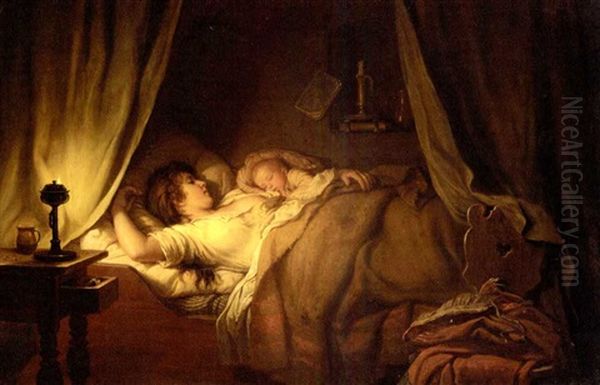
Johann Georg Meyer von Bremen stands as a master of 19th-century German genre painting. Emerging from the rigorous training of the Düsseldorf Academy, he developed a distinctive style characterized by meticulous detail, narrative clarity, and a warm, often sentimental, portrayal of everyday life. His depictions of Hessian peasants, innocent children, and intimate family moments resonated deeply with his contemporaries in Germany and abroad. While perhaps not an avant-garde innovator, his work skillfully captured the spirit of his time, bridging late Romantic sensibilities with the emerging interest in realistic depiction. Through his popular and enduring images, Meyer von Bremen created a rich and sympathetic portrait of 19th-century German life that continues to engage viewers today.